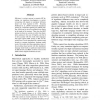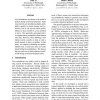ACL
2009
13 years 9 months ago
2009
An efficient decoding algorithm is a crucial element of any statistical machine translation system. Some researchers have noted certain similarities between SMT decoding and the f...
ACL
2009
13 years 9 months ago
2009
This paper proposes an approach to enhance dependency parsing in a language by using a translated treebank from another language. A simple statistical machine translation method, ...
ACL
2009
13 years 9 months ago
2009
Letter-to-phoneme (L2P) conversion is the process of producing a correct phoneme sequence for a word, given its letters. It is often desirable to reduce the quantity of training d...
ACL
2009
13 years 9 months ago
2009
Efficiency is a prime concern in syntactic MT decoding, yet significant developments in statistical parsing with respect to asymptotic efficiency haven't yet been explored in...
ACL
2009
13 years 9 months ago
2009
Computational story telling has sparked great interest in artificial intelligence, partly because of its relevance to educational and gaming applications. Traditionally, story gen...
ACL
2009
13 years 9 months ago
2009
Existing evaluation metrics for machine translation lack crucial robustness: their correlations with human quality judgments vary considerably across languages and genres. We beli...
ACL
2009
13 years 9 months ago
2009
User simulations are shown to be useful in spoken dialog system development. Since most current user simulations deploy probability models to mimic human user behaviors, how to se...
ACL
2009
13 years 9 months ago
2009
Empirical studies on corpora involve making measurements of several quantities for the purpose of comparing corpora, creating language models or to make generalizations about spec...
ACL
2009
13 years 9 months ago
2009
Statistical models in machine translation exhibit spurious ambiguity. That is, the probability of an output string is split among many distinct derivations (e.g., trees or segment...
ACL
2009
13 years 9 months ago
2009
The tree sequence based translation model allows the violation of syntactic boundaries in a rule to capture non-syntactic phrases, where a tree sequence is a contiguous sequence o...


